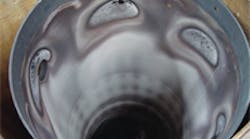Unlike manual processes such as acid stripping and grit blasting, a precision Abrasive Waterjet (AWJ) system automates the removal of coatings from turbine components, and without damaging them. AWJ is predictable, repeatable and an environmentally friendly process that also lowers total costs.
Superalloy components require coating systems to protect their base metals from the extraordinary operating environments of gas turbines. These tenacious coatings are designed to resist the oxidation and corrosion created by the combustion process in the turbine hot gas path. Unfortunately, the coatings also resist removal when they’ve become depleted during operation.
The AWJ process gently removes these tough coatings without compromising a part’s base metal integrity. There is no inter-granular attack or other issues with the process.
A 5-axis CNC AWJ system removes coatings in iterative steps. The process, developed by Huffman Corp. in conjunction with Springfield Manufacturing LLC, is much like a machine tool with material removal rates being controlled by speeds, feeds, pressures and material flow.
Since coating thicknesses naturally vary, an X-ray Fluorescent device reports elements such as Yttrium that decline in intensity as the base metal is approached. With this type of process control, it is sometimes possible to realize additional repair cycles in some components due to minimal damage to the substrate.
A further advantage of the CNC process is that it is a highly controlled mechanical removal process, comparable to a milling process with tight tolerance control. No chrome is put into the solution, like with acid, and since it is a mechanical process, the machine holds positional tolerance to less than 0.0005 in.
Software keeps the waterjet stream at a specific distance from the part surface, controls feed and speed, and maintains a normal offset over the entire part form. Coating thicknesses are measured before and after the AWJ process to ensure full removal of the bond coating and diffusion layer, as well as any contamination or corrosion under the bond coat. The process has the effect of removing craze cracking and deep cracks better than Fluoride Ion cleaning.
The remaining surface is also cleaned of all surface contamination and, in some cases, shows Directionally Solidified (DS) grain structure and DS etching. Most shops using this method then bag the part and send them directly to coating. Grit blasting recontaminates the surface and destroys the bond interface. Process controls measure “before” and “after” conditions to verify removal over the surfaces, where it is desired.
Thanks to the CNC of AWJ, single-part flow occurs that beneficially reduces risk of batch lot errors. Actual part processing time is much less than acid and grit blast, and at usually lower costs.
The AWJ process can remove the thermal barrier coating (TBC) and bond coat in one process. Conversely, grit blasting of TBC and bond coating in some cases may be slightly lower in cost, but at a higher total expense of lower service life and reduced repair cycles.
Based on a Six Sigma philosophy, the AWJ system eliminates the human variables associated with manual grit blasting. And the system allows for the generation of run charts.
Many shops, independent service providers and major OEMs have given the AWJ process much scrutiny, qualifications and approvals. As a result, its use continues to grow for stripping almost every frame and application, from blades (buckets), vanes (nozzles), and liners to transition pieces and shrouds.









